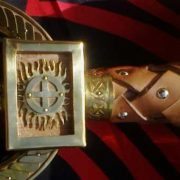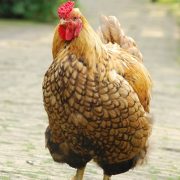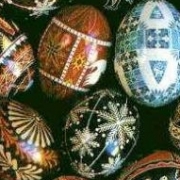Odinic Vision
By Shawn E AOR – ORBriefing 221 – Spring 2261
It has been accepted by many practitioners of Asatru, Heathenism, and Odinism that Odin, All Father of the Folk sacrificed his eye at some point in Mimir’s well. However, personally I have yet to find any evidence of this sacrifice for myself in the lore we generally accept as the Prose and Poetic Eddas… or logic. It is the intention of this article to explore what I have been able to find and share it. I do not claim that the following thoughts or ideas are original to me, however I do hope that it will induce thought and perhaps an awareness shift for those who do in fact accept this view. Considering some of the things which are readily found within the lore of the Eddas themselves, I feel that we will come to see a plausible thought that Odin did not sacrifice his eye but in fact gained vision through the opening of his “third” eye. Perhaps we can find something of a different view of Odinic Vision.
Voluspa is often one of the first quoted sources to support the idea that Odin sacrificed his eye into Mimir’s well. Consider closely the chosen language of the stanza as it is held over various translations.
“I know where Othin’s eye is hidden,
Deep in the wide-famed well of Mimir;
Mead from the pledge of Othin each morn
Does Mimir drink: would you know yet more?”[1]
Odin’s eye is hidden – not sacrificed “Deep in the wide-famed well of Mimir”? Mímir (Old Norse “The rememberer, the wise one”). I submit that we can extract from the symbolic nature of the Lore, that Mimir’s Well is a representation of the mind. Odin has two ravens – Hugin and Munin which he sends out over the Midgard. This is seen in Grímnismál:
“O’er Mithgarth Hugin and Munin both
Each day set forth to fly;
For Hugin I fear lest he come not home,
But for Munin my care is more.”[2]
So then we have All Father, sitting on a throne that allows him to look out over all realms sending forth both Hugin (Old Norse “Thought”), and Munin (Old Norse “Memory”) over Midgard and then listening to their reports when they return. He fears the loss of thought, but fears more the loss of memory. Interesting. Perhaps we can also submit that Odin’s pledge, which is the mead that Mimir drinks, is learning from all areas of the multiverse. Considering what functions of the mind we have seen so far, Odin is involved in thought, memory, and remembering. His thoughts are far reaching as is his memory which is remembered daily at the well of Mimir.
Pushing forward, I think you will find this interesting as well.
According to Snorri in his Prose Edda poem Gylfaginning, Gylfi is told that Odin has various names. I would like to focus on a select few of these names for this article.
“He saw three high-seats, each above the other, and three men sat thereon, one on each. And he asked what might be the name of those lords. He who had conducted him in answered that the one who sat on the nethermost high-seat was a king, “and his name is Hárr; (a) but the next is named Jafnhárr; (b) and he who is uppermost is called Thridi.” (c)”
(Translations: a. High. b. Equally High. c. Third.)[3]
Consider for a moment the structure of the human face. Notice the symmetry of the features and in most cases two visible eyes. Allow me to submit that these two visible eyes could be seen as “High” and “Equally High”. You might ask but what of “third”? If we have the other two, where is the third? Good questions. Consider for a moment the existence of a third eye, the pineal gland which is “located within the vertebrate brain between the left and right hemispheres. It is said that the Pineal gland is the “The Crown Chakra” or “The Third Eye” and that it is a Bio-luminescent gland that can improve learning capabilities, increase memory, enhance intuition, wisdom and creativity and may be the link to enhancing psychic abilities.”[4]
If we are able to accept this submission then we can further analyze what is known of Odin in the Lore found in Grímnismál. Sitting in his throne Hlidskjalf(Old Norse “Gate-Shelf”), Odin can look out over all the realms of Yggdrasil, yet he also sends forth his ravens (Thought and Memory) to fly over Midgard and report back, this learning is then considered the Mead offering of Mimir – the rememberer. Looking, thinking, memorizing, and remembering are all parts of various levels of sight and insight. So for me, the glaring question then becomes… “Why would Odin sacrifice his eye when so much if his role is involved with ‘sight’ or ‘insight’?”
I feel that with these findings we can illustrate that All Father Odin has been given names and roles that relate to various forms of physical sight and spiritual insight as well as the critical hindsight through the analysis of circumstances. These things relate to us as Odinists through our eyes and the pineal gland, for example, which allow for an understanding of our current environment. With these devices, the Odinic Vision can allow for (in)sight in various areas of our lives. Odinic Vision allows for an understanding of the moment, it offers foresight, and with the inclusion of memory, it also allows for hind sight. Odin is able to “see” the full spectrum of the Nornic offices of Past, Present, and Future. Thus Odin could not have given up his eye, but rather would have gained vision through the activation of his third eye.
May we all drink deep from Odin’s Pledge of Mimir’s well.
Sources:
http://www.northvegr.org/the%20eddas/the_poetic_edda-bellows/001_01.html
http://www.northvegr.org/the%20eddas/the_poetic_edda-bellows/005.html
http://www.northvegr.org/the%20eddas/the%20prose%20edda%20-%20brodeur%20translation/index%20page.html




